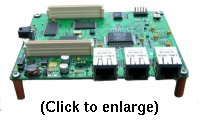Professor publishes hands-on intro to embedded Linux development
Dec 2, 2004 — by Henry Kingman — from the LinuxDevices Archive — viewsLinux Journal has published a gentle two-part introduction to embedded Linux development written by Richard A. Sevenich, a computer science professor at Eastern Washington University. The introduction explains enough about embedded Linux development to get the reader started on a hands-on course of self-study.
According to Sevenich, the barriers to entry into embedded development have dropped considerably in recent years, while a rebounding tech sector promises to create substantial employment opportunities for embedded developers. Formerly, embedded development required deep hardware knowledge, because embedded applications typically ran without an operating system underneath them. Now, embedded development teams comprise mainly application developers, possibly with a single “hardware guy” shared among them, according to Sevenich.
Sevenich recommends that prospective embedded developers get started by finding a relatively affordable SBC (single-board computer) known to run Linux. Other alternatives are to target an older Sharp Zaurus, such as the SL-5500, or even floppy disks, CDs, or USB pen drives.
 In his coursework, Professor Sevenich uses ETC's LBox (pictured at right), a uClinux board based on a Motorola Coldfire MCF5272 processor that Sevenich says costs about $250 in single quantities. The board comes with Flash memory, a serial port, a fiber port, up to three 10/100 Ethernet ports, and can work with power from 5- to 12-volts.
In his coursework, Professor Sevenich uses ETC's LBox (pictured at right), a uClinux board based on a Motorola Coldfire MCF5272 processor that Sevenich says costs about $250 in single quantities. The board comes with Flash memory, a serial port, a fiber port, up to three 10/100 Ethernet ports, and can work with power from 5- to 12-volts.
Sevenich covers how to set up the LBox, and connect it to a host PC or laptop with a DB9 cable or DB9-to-USB cable. Next, he explains how to connect to the board using minicom over a serial connection, or telnet over an Ethernet connection.
The next step involves setting up a cross-compilation tool chain, and mounting an NFS filesystem from the host on the target board. Finally, Sevenich walks the reader through a sample program called “bye” that offers a refreshing alternative to the usual “hello world” program.
Part I of the article is available here, while Part II is here.
Sevenich has also written several articles for LinuxDevices.com, including Retraining for Embedded Linux Development and Embedded Linux in academia — the problem and potential solutions.
This article was originally published on LinuxDevices.com and has been donated to the open source community by QuinStreet Inc. Please visit LinuxToday.com for up-to-date news and articles about Linux and open source.